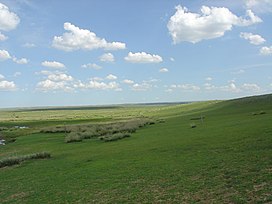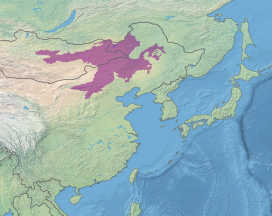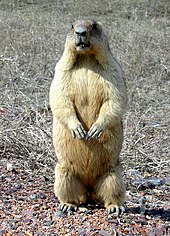Mongolian–Manchurian grassland
| Mongolian-Manchurian grassland | |
|---|---|
 | |
 Map of ecoregion in China and Mongolia | |
| Ecology | |
| Realm | Palearctic |
| Biome | Temperate grasslands, savannas, and shrublands |
| Geography | |
| Area | 887,000 km2(342,000 sq mi) |
| Countries | |
| Conservation | |
| Conservation status | Critical/endangered[1] |
| Protected | 5.09%[2] |
TheMongolian-Manchurian grassland,also known as theMongolian-Manchurian steppeorGobi-Manchurian steppe,in thetemperate grasslandbiome,is anecoregioninEast Asiacovering parts ofMongolia,theChinese Autonomous regionofInner Mongolia,andNortheast China.
Setting
[edit]The Mongolian-Manchurian grassland (Chinese:Mông cổ cao nguyên thảo nguyên - nội mông cổ thảo nguyên - đông bắc thảo nguyên) covers an area of 887,300 square kilometers (342,600 sq mi). Thistemperate grasslands, savannas, and shrublandsecoregionof thePalearctic realmforms a large crescent around theGobi Desert,extending across central and easternMongoliainto the eastern portion ofInner Mongoliaand eastern and centralManchuria,and then southwest across theNorth China Plain.To the northeast and north, theSelenge-OrkhonandDaurianforest steppesform a transition zone between the grassland and the forests ofSiberiato the north. On the east and southeast, the grasslands transition totemperate broadleaf and mixed forests,including theManchurian mixed forests,Northeast China Plain deciduous forests,andCentral China loess plateau mixed forests.On the southwest, the grasslands extend to theYellow River,across which is theOrdos Plateau steppe.It lies between theAltai Mountainsin the west and theGreater Khingan Regionin the east.
Climate
[edit]The climate is hypercontinental sub-humidorsemi-arid,with theKöppen classificationsBSkor in the extreme east,DwaorDwb.The region features warm summers with decreasing rainfall from east to west, alongside frigid, extremely dry winters. Being relatively dry, from a combination of being landlocked and the proximity of theSiberian High,only select animals can live here.
Flora
[edit]
The dominant flora consists of medium to tall grasslands, dominated byfeather grass(Stipa baicalensis,S. capillata,andS. grandis),sheep's fescue(Festuca ovina),Aneurolepidium chinense,Filifolium sibiricuman,andCleistogenes sqarrosa.The drier regions surrounding the Gobi host drought-tolerant grasses, together with forbs and low, spiny shrubs.
The southwestern slopes of theGreater Khinganrange support pockets of broadleaf deciduous forest, of eitherMongolian oak(Quercus mongolica), or a mixture ofpoplar(Populus davidianaandP. suaveolens),Siberian silver birch(Betula platyphylla), andwillow(Salix rorida).
There are also grasses such as:
- Feathergrass – lives long since it is rarely consumed
- Sheepgrass – perennial
- Lyme Grass – can provide food for animals
Fauna
[edit]
Despite its landscaping, wildlife can be found in a variety of habitats not restricted solely to the open steppe. Many are programmed to traverse vast distances inextreme weatherand terrain by running, digging, and/or flying.
- Theblack grouseoccupies the belt of steppe, forests, and mountains stretching across much of Asia.[3]
- Theblack-billed capercaillielives and forages mainly inlarchtaigafurther north of the steppe.
- TheDaurian partridgefeeds and hides in dense grassland and underbrush.
- Theringneck pheasanthas been introduced to similar grassland habitat in the United States for hunting and sport.
- Thebrown eared pheasant(Crossoptilon mantchuricum) is also adapted to the mountainous woodlands of Northeast China and other similar ecoregions.
- Thebobak marmot(Marmota bobak), also known as the steppe marmot, inhabits the area
- TheMongolian wolfis found throughout the region.
- TheMongolian wild ass(or onager) once covered vast steppe, though now exist in isolated patches.
- TheMongolian gazelleis numerous here.
- ThePrzewalski's horsehas been reintroduced here.
- Thecorsac foxdrinks very little water, instead, obtaining it mostly through their prey.
- Thebearded vulture'spowerful beak can hammer large bones against hard rock.
- Thenorthern goshawkcan be found in deciduous and coniferous woodland edges.
- Thesteppe eaglespecializes in seizing ground squirrels and other small mammals from their dens.
- Thesteppe lemmingis a very important prey base. Their presence in an area can limit the presence of other voles. Unfortunately, they can also very easily reduce vegetation if necessary. They are very good at burrowing in the terrain. They have a very big migration when it may get too cold.
- TheDaurian hedgehogis found in the forest-steppe and grasslands.
Environmental issues
[edit]
In the winter the grass becomes dry and very flammable, making wildfires more common. Grass recovers quickly from the fire, but trees do not. This partially explains the absence of trees in the area. There are also seasonal droughts in the grasslands, typically occurring during summer.
Culture
[edit]The majority of people in the steppe are Mongolian nomads. Families in the Mongolian steppe live in "gers" which are a type of large portable tent. Mongolians are also master horse riders so many families own many horses that roam the steppe. The people in the steppe use the animals there for their food and drink. They also have a very prominent musical culture with a wide variety of traditional Mongolian songs.
Conservation and threats
[edit]The Mongolian-Manchurian grassland faces threat from human expansion, though in most of its eastern area, it has not been altered by agriculture as much as its reaches in its western area, or similar grasslands inNorth America.[4][5]
Protected areas
[edit]5.09% of the ecoregion is in protected areas. Protected areas include:[2]
- Lkhachinvandad uul Nature Reserve (IUCN Category IV)
- Batkhaan uul Nature Reserve (IUCN Category IV)
- Xianghai Ramsar Site
- Zhalong Ramsar Site
- Dornod Mongol Strictly Protected Area (IUCN Category Ib)
- Numrug National Park(IUCN Category Ib)
- Mongol DaguurStrictly Protected Area (IUCN Category Ib)
- Mongol Daguur(Mongolian Dauria) Ramsar Site
- Khustain Nuruu National Park(IUCN Category II)
- Ugtam uul Nature Reserve (IUCN Category IV)
- Torey LakesRamsar Site
- Khangain nuruu National Park (IUCN Category II)
- Toson-Khulslai Nature Reserve (IUCN Category IV)
- Khar yamaat Nature Reserve (IUCN Category IV)
- Yakhi nuur Nature Reserve (IUCN Category IV)
- Dalai LakeNational Nature Reserve, Inner Mongolia Ramsar Site
- Buir Lakeand its surrounding wetlands Ramsar Site
- Ganga Lakeand its surrounding wetlands Ramsar Site
- Khugnu-Tarna National Park (IUCN Category II)
- Moltsog Els National Park (IUCN Category II)
- Orkhonii khundii National Park (IUCN Category II)
- Choiriin Bogd uul Nature Reserve (IUCN Category IV)
- Ongon Tavan bulag Nature Reserve (IUCN Category IV)
- Baga gazriin chuluu Nature monument (IUCN Category III)
- Darkhan uul Nature Reserve (IUCN Category IV)
- Kherlen Toono uul Nature Reserve (IUCN Category IV)
- Bayantsagaani tal Nature Reserve (IUCN Category IV)
- Darkhankhaan uul Nature monument (IUCN Category III)
- Undurkhaan uul National Park (IUCN Category II)
- Dariganga National Park (IUCN Category II)
- Jilin Momoge National Nature Reserve Ramsar Site
- Landscapes of DauriaWorld Heritage Site
- Ikh gazriin chuluu National Park (IUCN Category II)
- Borzinskoe Sol`-ozero Natural Monument (IUCN Category III)
- Sredneargunskij State Natural Zakaznik (IUCN Category IV)
References
[edit]- ^"Mongolian–Manchurian grassland".Terrestrial Ecoregions.World Wildlife Fund.
- ^ab"Mongolian–Manchurian grassland". Dopa Explorer. Accessed 3 July 2021.[1].
- ^"Northern Black Grouse (Lyrurus tetrix). Photo Gallery.Birds of Russian Far East".fareastru.birds.watch.Retrieved2020-09-08.
- ^Environment in East Asia & Pacific
- ^"Structure of threats to steppe biome in Russia - Conservation of steppes in Russia".
